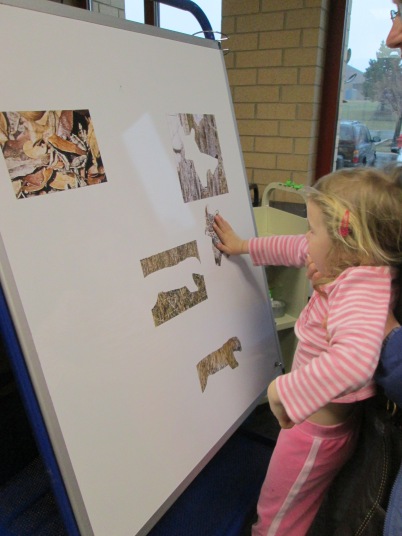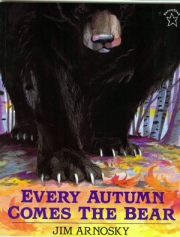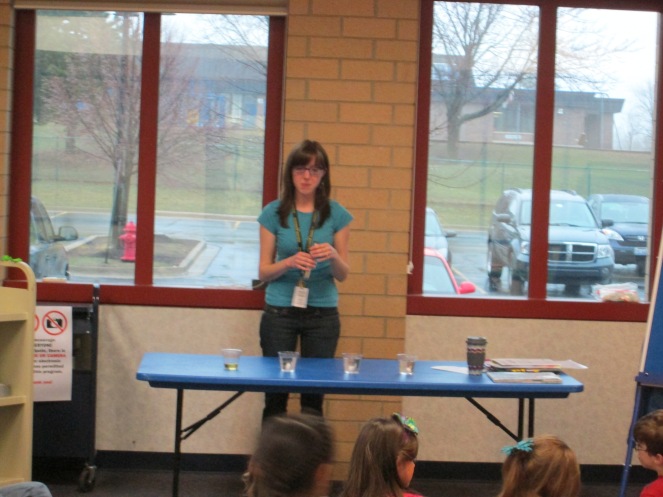Another successful STEAM program deployed–with very happy kids and grateful parents. I gave a brief description of STEAM in my last article about my STEAM program on weather so I will jump right in to my second program on animal adaptations.
Room Setup
- Half of the room is dedicated for storytime. This time I opted for no chairs and had the parents sit on the ground with their kids. Everybody was on the same level and kids weren’t attracted to sitting on chairs and being disconnected from the stories, rhymes, and activities.
- The other half of the room has stations for each activity. They are partially setup with items that aren’t distracting to children during storytime. After storytime, my lovely assistant (hi, Ann!) and I set up the rest of the stations. There are usually more stations than staff so we help at the stations that require the most guidance and/or supervision. This would be a great program for teen volunteers to help (because some are probably sick of the wax on/wax off cleaning of books)
Storytime Outline
1. Welcome song: We start with Shaking Our Sillies Out, Clapping Our Crazies Out, Bashing Our Brainies Out (that last one is NOT real)
2. I emphasize to parents the importance of the scientific observation–even at this young age. To put it simply: make predictions, test, observe & compare
3. Intro to theme book: Rain Forest Animal Adaptations by Lisa J. Amstutz
 4. Body Movement: Bird Song (to the tune of “Here We Go Round the Mulberry Bush”)
4. Body Movement: Bird Song (to the tune of “Here We Go Round the Mulberry Bush”)
5. Book: Where in the Wild? By David M. Schwartz & Yael Schy

Camouflage Rhyme
Oh where oh where can my little frog be?
Oh where oh where can he be?
With his big, buggy eyes
And his smooth, brown skin
Oh where oh where can he be?
Oh where oh where can my tiger be?
Oh where oh where can he be?
With his stripey fur
And his big, sharp teeth
Oh where oh where can he be?
Oh where oh where can my owl be?
Oh where oh where can he be?
With his amber eyes
And his short, curved beak
Oh where oh where can he be?
7. Transition: I Wiggle (Tune: For He’s a Jolly Good Fellow)
My thumbs are starting to wiggle,
My thumbs are starting to wiggle,
My thumbs are starting to wiggle,
Around, and around, and around.
…Arms, Legs, Head…
All of me is starting to wiggle,
All of me is starting to wiggle,
All of me is starting to wiggle,
And now I need to rest.
8. Book: Every Autumn Comes the Bear by Jim Arnosky
9. Experiment: Duck Oil
- 3 clear plastic cups with water
- 3 cotton balls
- 1 container with oil
How do ducks float? Paddling moves them, but how about when they sit there, bobbing in the waves? Their feathers have oil to protect them and help them float on the water. I tested to see how much oil their feathers need to keep the ducks afloat. The first cotton ball had no oil, the second cotton ball only had oil on the bottom half, and the third cotton ball was covered in oil. The more dense the cotton ball, the better. I also had the “ducks” dunk under the water to search for plants. The first didn’t come up, the second barely did then sank, and the third bobbed right back up.
10. Book: 11 Experiments That Failed by Jenny Offill & Nancy Carpenter
EXPERIMENT STATIONS
Station 1: Blubber Gloves
Station 2: Camouflaged colors
Station 3: Bird Beaks
SUPPLIES NEEDED
Station 1: Blubber Gloves
- Two large ziplock bags
- Shortening
- Duct tape
- Water
- Ice
- Bucket
Station 2: Camouflaged colors
- 4 sheets of butcher paper (5’ tall)
- Cut out animals to color
- Crayons in the colors of the butcher paper
Station 3: Bird Beaks
- Eye dropper or liquid medicine syringe (hummingbird)
- Large spoon (spoonbills, pelican)
- Clothespin (robins, blackbirds)
- Bowl of water (nectar)
- Bowl of water with paperclips (fish)
- Bowl of dirt with jelly worms (clothespin)













2 thoughts on “Curious Kitties: Animal Adaptations”